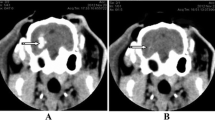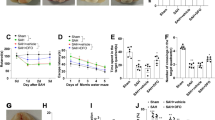Abstract
Deferoxamine (DFX), a potent iron-chelating agent, reduces brain edema and neuronal cell injury that develop due to the hemolysis cascade. Statins have neuroprotective effects via anti-inflammatory action and increment of cerebral blood flow after intracerebral hemorrhage (ICH). The purpose of this study was to identify the effects of combined DFX and statins treatment in an experimental ICH rat model. The treatments were: intraperitoneal (i.p.) injection of DFX (group I), combined treatment of i.p. DFX and oral statins (group II), statins only (group III) and treatment with vehicle (group IV). Induction of ICH was performed with injection of bacterial collagenase type IV into the left striatum. After removal of the brain, hematoma volume, water content and brain atrophy were measured. Immunohistochemistry in the perihematomal region was performed for identification of microglial infiltration, astrocyte expression and apoptotic cell presence. Statistical analysis was performed using the non-parametric Kruskal–Wallis test and significance was evaluated when the p value was less than 0.05. According to behavioral tests, significant differences among treatment groups were noted 4 weeks after ICH induction (p < 0.05). However, there were no significant differences among treatment groups in hematoma volume, brain water content or brain atrophy. In the perihematomal area, the activated microglial cells were reduced in the combined treatment group. Among the four groups, a significant difference in immunohistochemical staining was identified (p < 0.05). These results suggest that combined treatment with DFX and statins improves neurologic outcomes after ICH through reduction of microglial infiltration, apoptosis, inflammation and brain edema.




Similar content being viewed by others
References
Sacco S, Marini C, Toni S, Olivieri L, Carolei A (2009) Incidence and 10-year survival of intracerebral hemorrhage in population-based registry. Stroke 40:394–399
Xi G, Keep RF, Hoff JT (2006) Mechanisms of brain injury after intracerebral haemorrhage. Lancet Neurol 5:53–63
Xue M, Del Bigio MR (2000) Intracerebral injection of autologous whole blood in rats: time course of inflammation and cell death. Neurosci Lett 283:230–232
Jung JH, Chu K, Jeong SW, Han SY, Lee ST, Kim JY, Kim MH, Roh JK (2004) HMG-CoA reductase inhibitor, atorvastatin, promotes sensorimotor recovery, suppressing acute inflammatory reaction after experimental intracerebral hemorrhage. Stroke 35:1744–1749
Okauchi M, Hua Y, Keep RF, Morgenstern LB, Schallert T, Xi G (2010) Deferoxamine treatment for intracerebral hemorrhage in aged rats. Therapeutic time window and optimal duration. Stroke 41:375–382
Selim M (2009) Deferoxamine mesylate. A new hope for intracerebral hemorrhage: from bench to clinical trials. Stroke 40:S90–S91
Chen J, Zhang ZG, Li Y, Wang Y, Wang L, Jiang H, Zhang C, Lu M, Katakowski M, Feldkamp CS, Chopp M (2003) Statins induce angiogenesis, neurogenesis, and synaptogenesis after stroke. Ann Neurol 53:743–751
Gu Y, Hua Y, Keep RF, Morgenstern LB, Xi G (2009) Deferoxamine reduces intracerebral hematoma-induced iron accumulation and neuronal death in piglets. Stroke 40:2241–2243
Xing Y, Hua Y, Keep RF, Xi G (2009) Effects of deferoxamine on brain injury after transient focal cerebral ischemia in rats with hyperglycemia. Brain Res 1291:113–121
Kawashima S, Yamashita T, Miwa Y, Ozaki M, Namiki M, Hirase T, Inoue N, Hirata K, Yokoyama M (2003) HMG-CoA reductase inhibitor has protective effects against stroke events in stroke-prone spontaneously hypertensive rats. Stroke 34:157–163
Song EC, Chu K, Jeong SW, Jung KH, Kim SH, Kim M, Yoon BW (2003) Hyperglycemia exacerbates brain edema and perihematomal cell death after intracerebral hemorrhage. Stroke 34:2215–2220
Hua Y, Schallert T, Keep RF, Wu J, Hoff JT, Xi G (2002) Behavioral tests after intracerebral hemorrhage in the rat. Stroke 33:2478–2784
Zazulia AR, Diringer MN, Derdeyn CP, Powers WJ (1999) Progression of mass effect after intracerebral hemorrhage. Stroke 30:1167–1173
Yang GY, Betz AL, Chenevert TL, Brunberg JA, Hoff JT (1994) Experimental intracerebral hemorrhage: relationship between brain edema, blood flow, and blood-brain barrier permeability in rats. J Neurosurg 81:93–102
Xi G, Keep RF, Hoff JT (1998) Erythrocytes and delayed brain edema formation following intracerebral hemorrhage in rats. J Neurosurg 89:991–996
Xi G, Wagner KR, Keep RF, Hua Y, de Courten-Myers GM, Broderick JP, Brott TG, Hoff JT (1998) The role of blood clot formation on early edema development following experimental intracerebral hemorrhage. Stroke 29:2580–2586
Wu J, Hua Y, Keep RF, Nakamura T, Hoff JT, Xi G (2003) Iron and iron-handling proteins in the brain after intracerebral hemorrhage. Stroke 34:2964–2969
Nogawa S, Forster C, Zhang F, Nagayama M, Ross ME, Iadecola C (1998) Interaction between inducible nitric oxide synthase and cyclooxygenase-2 after cerebral ischemia. Proc Natl Acad Sci USA 95:10966–10971
Tanji K, Imaizumi T, Matsumiya T, Itaya H, Fujimoto K, Cui X, Toki T, Ito E, Yoshida H, Wakabayashi K, Satoh K (2001) Desferrioxamine, an iron chelator, upregulates cyclooxygenase-2 expression and prostaglandin production in a human macrophage cell line. Biochim Biophys Acta 1530:227–235
Nakamura T, Keep RF, Hua Y, Schallert T, Hoff JT, Xi G (2004) Deferoxamine-induced attenuation of brain edema and neurological deficits in a rat model of intracerebral hemorrhage. J Neurosurg 100:672–678
Okauchi M, Hua Y, Keep RF, Morgenstern LB, Xi G (2009) Effects of deferoxamine on intracerebral hemorrhage-induced brain injury in aged rats. Stroke 40:1858–1863
Tapia-Perez H, Sanchez-Aguilar M, Torres-Corzo JG, Rodriguez-Leyva I, Gonzalez-Aguirre D, Gordillo-Moscoso A, Chalita-Williams C (2009) Use of statins for the treatment of spontaneous intracerebral hemorrhage: results of a pilot study. Cen Eur Neurosurg 70:15–20
Cappellini MD, Musallam KM, Taher AT (2009) Overview of iron chelation therapy with desferrioxamine and deferiprone. Hemoglobin 33(Suppl 1):S58–S69
Acknowledgments
This work was supported by the research fund of Hanyang University (HY-2010-C).
Author information
Authors and Affiliations
Corresponding author
Rights and permissions
About this article
Cite this article
Chun, HJ., Kim, D.W., Yi, HJ. et al. Effects of statin and deferoxamine administration on neurological outcomes in a rat model of intracerebral hemorrhage. Neurol Sci 33, 289–296 (2012). https://doi.org/10.1007/s10072-011-0733-y
Received:
Accepted:
Published:
Issue Date:
DOI: https://doi.org/10.1007/s10072-011-0733-y




